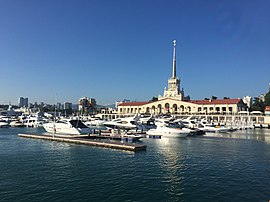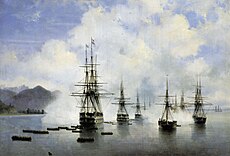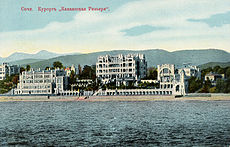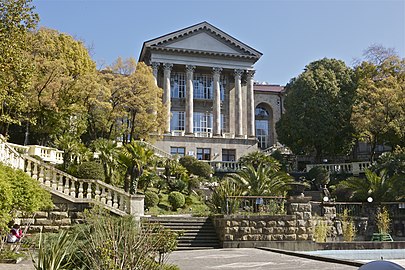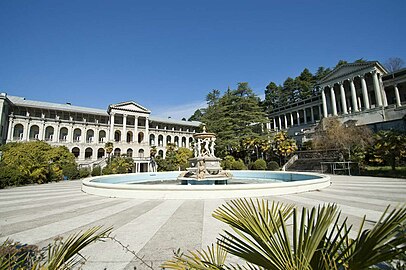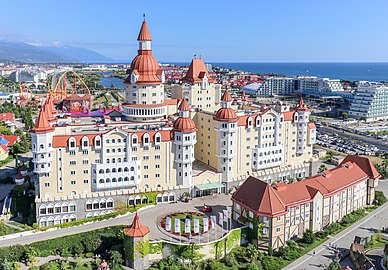Sochi
Sochi
Сочи | |
|---|---|
City[1] | |
|
From top: Port of Sochi, Sochi Park, Winter Theatre, Sochi Olympic Park, Adler Railway Station Bird's-eye view of Sochi | |
| Postal code(s)[10] | 354000, 354002–354004, 354008–354010, 354013, 354014, 354018, 354019, 354022, 354024, 354025, 354030, 354031, 354033, 354036, 354037, 354039, 354053–354055, 354057, 354059, 354061, 354065–354068, 354071, 354073, 354084, 354099, 354200, 354202–354214, 354216–354218, 354220, 354226, 354231, 354233, 354299, 354340, 354346, 354348, 354349, 354354, 354355, 354364, 354380, 354382, 354383, 354399, 993501 |
| Dialing code(s) | +7 862 |
| OKTMO ID | 03726000001 |
| Website | sochiadm |
Sochi (Russian: Сочи, IPA: [ˈsotɕɪ] ⓘ, from Ubykh: Шъуача – seaside) is the largest resort city in Russia. The city is situated on the Sochi River, along the Black Sea in Southern Russia, with a population of 466,078 residents,[12] and up to 600,000 residents in the urban area. The city covers an area of 176.77 square kilometers (68.25 sq mi),[5] while the Greater Sochi Area covers over 3,502 square kilometers (1,352 sq mi).[5] Sochi stretches across 145 kilometers (90 mi), and is the longest city in Europe,[13] the fifth-largest city in the Southern Federal District, the second-largest city in Krasnodar Krai, and the sixth-largest city on the Black Sea.
Sochi hosted the XXII Olympic Winter Games and XI Paralympic Winter Games in 2014. It hosted the alpine and Nordic Olympic events at the nearby ski resort of Rosa Khutor in Krasnaya Polyana. It also hosted the Formula 1 Russian Grand Prix from 2014 until 2021.[14][15][16] It was also one of the host cities for the 2018 FIFA World Cup.
Etymology
The general consensus (also recognized by the city's own website[17]) is that the name "Sochi" (Russian: Сочи) is the Russified form of the Circassian "Ş̂açə" (Adyghe: Шъачэ) which in turn is of Ubykh-Circassian origin, coming from the Ubykh name "Ş̂uaça" (Ubykh: Шъуача).[18][19][17] It is a compound made up from the two Ubykh words "шъуа" (sea) and "ча" (side) and roughly translates to "Seaside/coast".[19] There are other claims and theories, according to Georgian sources, the word comes from the Georgian word for "fir", "soch'i" (Georgian: სოჭი).[20]
History
Colchis 13th century BC–63 AD
Achaemenid Empire 511 BC–330 BC
Kingdom of Pontus 111 BC–62 BC
Roman Empire 62 BC–337 AD
Kingdom of Lazica337–697
Byzantine Empire 697–786
Kingdom of Abkhazia 778–1008
Kingdom of Georgia 1008–1490
Mongol Empire 1242–1259
Principality of Abkhazia 1491–1829
Ottoman Empire 1578–1829
Circassia 1829–1864
Russian Empire 1864–1917
Russian Republic 1917–1918
Russian Soviet Federative Socialist Republic 1918
Georgian Democratic Republic1918–1919
South Russia 1919–1920
Russian Soviet Federative Socialist Republic 1920–1991
Russian Soviet Federative Socialist Republic 1922–1991
Russian Federation1991–present
Early history
Before the whole area was conquered by
Between the 13th and 15th centuries, the Republic of Genoa had the monopoly of the trade on the shores of the Black Sea, and established colonies and trading posts in the region of the present-day Sochi, the large ones were Layso and Costa.[22][23][24]
From the 14th to the 19th centuries, the region was dominated by the
Russian Empire
The coastline was occupied by Russia in 1829 as a result of the
The Russians had no detailed knowledge of the area until Baron
The last battle of the
Circassian genocide
By the end of
Starting in 1866 the coast was actively colonized by Russians, Armenians, Ukrainians, Belarusians, Greeks, Germans, Georgians and other people from inner Russia.
-
Plan of Fort Alexandria at the mouth of Sochi, which initiated the city of Sochi
-
The landing of Nikolay Raevsky's squadron at Subashi, 1839 by Ivan Aivazovsky
-
Adyghe strike on a Russian Military Fort in 1840 during the Russian-Circassians War
-
The "Kavkazskaya Riviera" resort in Sochi, ca. 1909
-
Map of Sochi in 1913 (Russian edition)
Soviet time
During the
Sochi was established as a fashionable resort area under Joseph Stalin, who had his favorite dacha built in the city. Stalin's study, complete with a wax statue of the leader, is now open to the public.[34] During Stalin's reign the coast became dotted with imposing Neoclassical buildings, exemplified by the opulent Rodina and Ordzhonikidze sanatoriums. The centerpiece of this early period is Shchusev's Constructivist Institute of Rheumatology (1927–1931). The area was continuously developed until the demise of the Soviet Union.[3]
Modern Russia
Following Russia's loss of the traditionally popular resorts of the
In 2019, an area in the Imereti Lowlands was divided from Adlersky City District and formed as a separate urban-type settlement named Sirius. It was later designated as a federal territory.[37]
-
Ordzhonikidze resort, built in 1937–1955
-
Promenade in Sochi, 1973
-
St. Vladimir Church, built in 2005–2011
Geography
Greater Sochi is elongated along the Black Sea coast for 145 kilometers (90 mi). Sochi is approximately 1,603 kilometers (996 mi) from Moscow.[38]
The city of Sochi borders with Tuapsinsky District in the northwest, with Apsheronsky District and with Maykopsky District of the Republic of Adygea in the north, with Mostovsky District in the northeast, and with Georgia/Abkhazia in the southeast. From the southwest, it is bordered by the Black Sea.
The vast majority of the population of Sochi lives in a narrow strip along the coast and is organized in independent microdistricts (formerly settlements). The biggest of these microdistricts, from the northwest to the southeast, are
The northeastern part of the city belongs to the
Sochi has a humid subtropical climate[39][40] with mild winters (average 11 °C (52 °F) during the day and 4 °C (39 °F) at night) in the period from December to March and warm summers (average 24 °C (75 °F) during the day and 16 °C (61 °F) at night) in the period from May to October.
Layout and landmarks
Sochi is unique among larger Russian cities as having some aspects of a
-
Sochi's quay
-
Hotels
-
Aerial view of Sochi
-
Monument to Peter I in the seaport berth
A UNESCO World Heritage Site, the 2,957 square kilometers (731,000 acres) Caucasus Nature Reserve, lies just north from the city.[42] Sochi also has the region's most northerly tea plantations.
Climate
Sochi has a
| Climate data for Sochi (1991–2020, extremes 1870–present) | |||||||||||||
|---|---|---|---|---|---|---|---|---|---|---|---|---|---|
| Month | Jan | Feb | Mar | Apr | May | Jun | Jul | Aug | Sep | Oct | Nov | Dec | Year |
| Record high °C (°F) | 22.4 (72.3) |
23.5 (74.3) |
30.0 (86.0) |
33.7 (92.7) |
34.7 (94.5) |
35.2 (95.4) |
39.4 (102.9) |
38.5 (101.3) |
36.0 (96.8) |
32.1 (89.8) |
29.1 (84.4) |
23.5 (74.3) |
39.4 (102.9) |
| Mean daily maximum °C (°F) | 9.9 (49.8) |
10.4 (50.7) |
12.7 (54.9) |
17.0 (62.6) |
21.2 (70.2) |
25.4 (77.7) |
27.9 (82.2) |
28.6 (83.5) |
25.2 (77.4) |
20.7 (69.3) |
15.6 (60.1) |
12.0 (53.6) |
18.9 (66.0) |
| Daily mean °C (°F) | 6.3 (43.3) |
6.5 (43.7) |
8.6 (47.5) |
12.3 (54.1) |
16.6 (61.9) |
20.9 (69.6) |
23.7 (74.7) |
24.3 (75.7) |
20.5 (68.9) |
16.2 (61.2) |
11.4 (52.5) |
8.3 (46.9) |
14.6 (58.3) |
| Mean daily minimum °C (°F) | 3.8 (38.8) |
3.7 (38.7) |
5.6 (42.1) |
9.0 (48.2) |
13.3 (55.9) |
17.4 (63.3) |
20.0 (68.0) |
20.7 (69.3) |
16.9 (62.4) |
13.1 (55.6) |
8.5 (47.3) |
5.7 (42.3) |
11.5 (52.7) |
| Record low °C (°F) | −13.4 (7.9) |
−12.6 (9.3) |
−7.0 (19.4) |
−5.0 (23.0) |
3.0 (37.4) |
7.1 (44.8) |
12.6 (54.7) |
10.4 (50.7) |
2.7 (36.9) |
−3.2 (26.2) |
−5.4 (22.3) |
−8.3 (17.1) |
−13.4 (7.9) |
| Average precipitation mm (inches) | 177 (7.0) |
134 (5.3) |
133 (5.2) |
109 (4.3) |
107 (4.2) |
95 (3.7) |
120 (4.7) |
106 (4.2) |
140 (5.5) |
177 (7.0) |
175 (6.9) |
178 (7.0) |
1,651 (65.0) |
| Average extreme snow depth cm (inches) | 1 (0.4) |
1 (0.4) |
0 (0) |
0 (0) |
0 (0) |
0 (0) |
0 (0) |
0 (0) |
0 (0) |
0 (0) |
0 (0) |
0 (0) |
1 (0.4) |
| Average rainy days | 19 | 18 | 18 | 18 | 16 | 14 | 11 | 10 | 13 | 15 | 17 | 20 | 189 |
| Average snowy days | 6 | 6 | 3 | 0.3 | 0 | 0 | 0 | 0 | 0 | 0 | 1 | 4 | 20 |
| Average relative humidity (%)
|
73 | 72 | 72 | 75 | 79 | 79 | 79 | 78 | 76 | 76 | 74 | 72 | 75 |
| Mean monthly sunshine hours | 96 | 105 | 145 | 161 | 221 | 258 | 279 | 281 | 226 | 195 | 121 | 86 | 2,174 |
| Source 1: Pogoda.ru.net[45] | |||||||||||||
| Source 2: NOAA (sun, 1961–1990)[46] | |||||||||||||
| Beach climate data for Sochi | |||||||||||||
|---|---|---|---|---|---|---|---|---|---|---|---|---|---|
| Month | Jan | Feb | Mar | Apr | May | Jun | Jul | Aug | Sep | Oct | Nov | Dec | Year |
| Average sea temperature °C (°F) | 10.6 (51.08) |
9.4 (48.92) |
9.4 (48.92) |
11.5 (52.7) |
17.3 (63.14) |
22.9 (73.22) |
25.6 (78.08) |
26.9 (80.42) |
24.7 (76.46) |
20.5 (68.9) |
16.4 (61.52) |
12.8 (55.04) |
17.3 (63.2) |
| Source:[47] | |||||||||||||
Administrative and municipal status and city divisions

Within the
Sochi is administratively subdivided into four city districts: Tsentralny City District, Lazarevsky City District, Khostinsky City District, and Adlersky City District. Tsentralny City District, comprising the central portion of, is by far the smallest out of four in terms of the area, and the other three have comparable areas, with Lazarevsky City District being the biggest. In terms of the population, Tsentralny City District is approximately twice as big as each of the other three city districts.
|

|
Tsentralny City District

- Michael Archangel Cathedral, a diminutive church built in 1873–1891 to Kaminsky's designs in order to commemorate the victorious conclusion of the Caucasian War.
- The red-granite Archangel Column, erected in 2006 in memory of the Russian soldiers fallen in Sochi during the Caucasian War. It is capped by a 7-metre bronze statue of Sochi's patron saint, Michael the Archangel.
- Sochi Arboretum, a large botanical garden with tropical trees from many countries, and the Mayors Alleé—a landscape avenue of palm trees planted by mayors from cities around the world.
- The hybrid citrus tree planted in 1934 in the Subtropical Botanic Garden. Since 1940 numerous citrus cultivars from foreign countries have been graftedonto this tree as a token of friendship and peace. The associated Friendship Tree Garden Museum has a collection of 20,000 commemorative presents from around the world.
Lazarevsky City District

Lazarevsky City District lies to the northwest from the city center; the 2010 Census showed the population of 63,894 people.[6] It is the largest city district by area, covering some 1,744 square kilometers (673 sq mi) and comprising several microdistricts:
- delphinarium, an old church (1903), and a new church (1999). The settlement was founded as a Russian military outpost in 1839 and was named after Admiral Mikhail Lazarev.
- Loo, 18 km (11 mi) from the city center, was once owned by Princes Loov, a noble Abkhazian family. The district contains the ruins of a medieval church, founded in the 8th century, rebuilt in the 11th century, and converted into a fortress in the Late Middle Ages.
- Dagomys, 18 km (11 mi) from the city center, has been noted for its botanical garden, established by order of Nicholas II, as well as tea plantations and factories. A sprawling hotel complex was opened there in 1982. Dagomys adjoins Bocharov Ruchey, a dacha built for Kliment Voroshilov in the 1950s, but later upgraded into a country residence of the President of Russia, where he normally spends his vacations and often confers with leaders of other states.
- Decembrists used to serve. The fort was intentionally destroyed by Russian forces at the beginning of the Crimean War, so as to avoid its capture by the enemy.
- Fort Godlik, of which little remains, had a turbulent history. It was built at the mouth of the Godlik River in the Byzantine period (5th to 8th centuries), was destroyed by the Khazars and revived by the Genoese in the High Middle Ages.
Khostinsky City District

Khostinsky City District, sprawling to the southeast from the city center, occupies approximately 374 square kilometers (144 sq mi), with a population of 65,229 as of the 2010 Census.[6] The district is traversed by many rivulets which give their names to the microdistricts of Matsesta ("flame-colored river"), Kudepsta, and Khosta ("the river of boars").
Adlersky City District
Adlersky City District, with an area of 1,352 square kilometers (522 sq mi) and a population of 76,534 people as of the 2010 Census,[6] is the southernmost district of the city, located just north of the border with Abkhazia. Until the establishment of Greater Sochi in 1961, it was administered as a separate town, which had its origin in an ancient Sadz village and a medieval Genoese trading post.
Among the natural wonders of the district is the Akhshtyr Gorge with a 160-meter-long cave that contains traces of human habitation. The upland part of the district includes a network of remote mountain villages (
Demographics
Sochi has an ethnic
| Year | Total population | Urban | Russians | Armenians | Ukrainians | Georgians |
|---|---|---|---|---|---|---|
| 1887 | 98 | — | ||||
| 1891 | 460 | — | ||||
| 1897[51] | 1,352 | — | 37.9% | 6.0% | 19.9% | 17.1% |
| 1904 | 8,163 | — | ||||
| 1916 | 13,254 | — | ||||
| 1926 | 13,000 | — | ||||
| 1939 | 72,597 | 49,813 | ||||
| 1959 | 127,000 | 81,912 | ||||
| 1970 | 245,300 | 203,100 | ||||
| 1979 | 292,300 | 245,600 | ||||
| 1989[52] | 385,851 | 339,814 | ||||
| 1992 | 369,900 | 322,400 | 68.7% | 14.2% | 5.9% | 1.5% |
| 1994 | 378,300 | — | ||||
| 1997 | 388,200 | — | ||||
| 2002[53][54] | 397,103 | 332,778 | 67.5% | 20.2% | 3.7% | 2.3% |
| 2006 | 395,012 | 329,481 | ||||
| 2007 | 402,043 | 331,059 | ||||
| 2008 | 406,800 | 334,282 | ||||
| 2009 | 410,987 | 337,947 | ||||
| 2010[6] | 420,589 | 347,932 | 69.92% | 20.09% | 2.29% | 2.03% |
| Source, unless otherwise marked:[2][55][32][33] | ||||||
Religion

The Byzantine Empire brought Christianity to the Sochi region in the Middle Ages.[citation needed] The region was relatively isolated before 1829.[citation needed] In the North, a few hundred Sunni Muslim Shapsugs, a part of the Circassian nation, lived around Tkhagapsh, near Lazarevskoye. The Circassians (also known as Adyghe) converted to Islam from Christianity in the 17th century.[56] In the nineteenth century, Islam spread to the region.[citation needed]
Currently, Sochi is a large predominantly
A mosque was built in 2008 by United Arab Emirates in the central area of Bytkha, in addition to the old mosque being around 40 km (25 miles) north of the city center[57][58] in the Adyghe aul of Tkhagapsh.
There are around thirty
Economy
Overview
| Year | Billion rubles
|
|---|---|
| 2014 | 136
|
| 2015 | 150
|
| 2016 | 170.8
|
| 2017 | 191.3
|
Sochi is an economic centre of Krasnodar Krai and Russia. According to the economist-geographer Natalia Zubarevich, Sochi, being a "recreational capital", along with the largest industrial centers, acts as a "motor" of development that determines the prospects and directions of the country's development.[63] The economy of Sochi is based on trade, construction, resort and tourism. Its structure for 2015: retail trade (59%), construction (15%), resorts and tourism (11%), industry (10.6%), transport (3.5%) and agriculture (0.9%).[64] Sochi is one of the most popular tourism centres, as well as a prominent financial centre in Russia. Investments in the city's economy over the past 10 years have amounted to more than 1.1 trillion rubles.[64] The turnover of medium and large enterprises in Sochi in 2017 amounted to more than 191.3 billion rubles. The increase in turnover in comparison with the previous year is 12%.[62]
In 2010, Sochi headed the "Rating of Russian cities by quality of life" of the Urbanika Institute,[65] and in 2014 and 2015 it ranked as 4th and 5th city respectively;[66][67] experts noted the high rate of development of the city, large-scale investments on the eve of the 2014 Winter Olympics, favorable environmental conditions and high safety of residents.[68] In 2012, Sochi topped the rating of "30 best cities for business" in Russia, by Forbes.[69]
Tourism
Today, 705 classified accommodation facilities operate on its territory, including: 66 sanatoriums, 20 boarding houses and recreation centers and 618 hotels. 183 beach areas have been opened, more than 100 tourist facilities operate, about 70 excursion companies operate.[61]
Over 5.2 million tourists visited Sochi in 2016, 5.9% more than in 2015.[61] The average annual occupancy rate of hotels was at 77%, but varies by season. The importance of tourism for the development of Sochi is also determined by the financial revenues from the industry. According to statistics, in 2015, tourism revenues amounted to about 30 billion rubles. At the same time, throughout the country, revenues from the industry amounted to 161 billion rubles; thus, the tourist industry of the city occupies 18.6% of the total market of the country.[70]
-
Sanatorium Metallurg
-
Sanatorium Ordzhonikidze
-
Primorskaya Hotel
-
Bogatyr hotel
-
Rodina Grand Hotel pool
-
Sochipark in the evening
Trade, finance and services
The retail trade turnover for medium and large enterprises (accounting for about 30% of the total turnover) in the city in 2016 amounted to 57.2 billion rubles. On the territory of the city there are 8,769 objects of the consumer sphere, of which: 5013 are stationary retail enterprises, 1450 are catering enterprises, 335 are wholesale enterprises, and 1083 are service enterprises.[61] In Sochi, 1807 grocery stores, 2,708 non-food stores, 294 stores of a mixed group of goods, 178 pharmacies, 16 car dealerships, 20 stores at gas stations, 945 pavilions and kiosks have been opened. The provision of the population with retail space is 1,106.7 m2 (11,912 sq ft) per 1000 people.[61]
According to 2017 data, the annual trade turnover per capita in Sochi was 1.75 times higher than the average in Russia (373,527 rubles per year per person). At the same time, it exceeds the annual trade turnover per capita in all cities with a population of over one million, including Saint Petersburg and Moscow. A high trade turnover is ensured by both a large flow of tourists and a high average wage in the city. The annual retail turnover generated by permanent residents is about 96.2 billion rubles (52%). Tourists generate about 87.83 billion rubles (48%).[71]
The turnover of public catering in the city in 2016 for medium and large enterprises amounted to 7 billion rubles (about 36% of the total turnover). 1450 public catering establishments were opened in Sochi, with a total of 90473 seats. The market of paid services to the population in 2016 amounted to 34.3 million rubles; the industry employs 3393 people, with a total of 1083 enterprises.[61]
Industry and agriculture
The volume of goods shipped in 2016 for medium and large industrial enterprises of the city amounted to 19.4 billion rubles. The distribution of energy, gas and water accounted for 11.9 billion rubles,[61] the largest enterprises in the industry are: Adler TPP and Sochinskaya TPP. Processing industries accounted for 3.3 billion rubles.[61] The volume of shipment of minerals amounted to 76 million rubles, the largest enterprise in the industry is Firma Sochinerud.[61]
In the manufacturing industry, the overwhelming share of food production enterprises, which account for 92.3% of the production volume.[61] Large enterprises: Sochi meat-packing plant, Trout-breeding farm, Primorskaya quail farm, Sochi bakery and Lazarevsky bakery.
The volume of shipped agricultural products in 2016 amounted to 49.8 million rubles. Vegetables, citrus fruits, fruits (including heat-loving crops such as feijoa, medlar, kiwi) and flowers are cultivated by large agricultural enterprises: Verlioka, Voskhod and Pobeda. The only producer of poultry meat is the Adler Poultry Factory. Five enterprises are engaged in the cultivation and processing of tea: Dagomyschay, Solokhaul tea, Matsesta tea, Khosta tea, Shapsug tea and a number of farmers.[61]
-
Adler TPP
-
Tea plantations near Akhintam
-
Trout farming near Adler
Education

There are more than 70 secondary schools in Sochi.
In addition to branches of metropolitan universities, Sochi has its own higher educational institutions, which are also of federal importance:
- Sochi State University
- Russian International Olympic University
- Sochi Institute of Peoples' Friendship University of Russia
- International Innovation University
- Sochi Institute of Fashion, Business and Law
- Sochi Maritime Institute
- Sochi Branch of the Russian State Social University
- Sochi Branch of the Russian State University of Justice
- Sochi Branch of the Moscow New Law Institute
- Sochi Branch of the Moscow Automobile and Highway State Technical University
- Sochi Branch of the Adyghe State University
Secondary specialized educational institutions:
- College of Economics and Technology at Sochi State University
- College of Art
- College of Multicultural Education
- Medical College
- Professional Technical School
- Kuban College of Law
- Sochi Financial and Law College
- Sochi College of Humanities and Economics
Science
Sochi is indispensable for Russian science from a geographical and climatic point of view. The only subtropics in Russia are actively used as a base for scientific research in the field of botany, medicine and coastal construction. In addition to higher education institutions that develop science, Sochi has a number of research institutions of all-Russian importance:
- Sochi Research Center of the Russian Academy of Sciences
- Research Institute of Medical Primatology, Russian Academy of Medical Sciences
- Research Institute of Mountain Forestry and Forest Ecology of the Ministry of Natural Resources of the Russian Federation
- All-Russian Scientific Research Institute of Floriculture and Subtropical Crops of the Russian Academy of Agricultural Sciences
- Sochi Branch of the Russian Geographical Society
Sports
Sports facilities
A local tennis school spawned the careers of such players as Grand Slam champions Maria Sharapova and Yevgeny Kafelnikov (Kafelnikov spent much of his childhood here, while Sharapova relocated to Florida at the age of seven). In late 2005, the Russian Football Union announced that it was planning to establish a year-round training center for the country's national teams in Sochi. The city's warm climate was cited as one of the main incentives. Sochi is also the home for the football team PFC Sochi which plays in the Russian Premier League and for the ice hockey team HC Sochi which plays in the Kontinental Hockey League.
2014 Winter Olympics and Paralympics

The nearby ski resort of Roza Khutor at Krasnaya Polyana was the location of the alpine and Nordic events for the 2014 Winter Olympics.
In June 2006, the International Olympic Committee announced that Sochi had been selected as a finalist city to host the 2014 Winter Olympics and the 2014 Winter Paralympics. On July 4, 2007, Sochi was announced as the host city of the 2014 Winter Games, edging out Pyeongchang, South Korea and Salzburg, Austria.[72]
This was Russia's first time hosting the Winter Olympic Games, and its first time hosting the Paralympic Games. The site of a training centre for aspiring Olympic athletes, in 2008, the city had no world-class level athletic facilities fit for international competition.[73] Severe cost overruns made the 2014 Winter Olympics the most expensive Olympics in history; with Russian politician Boris Nemtsov citing allegations of corruption among government officials,[74] and Allison Stewart of the Saïd Business School at Oxford citing tight relationships between the government and construction firms.[75] While originally budgeted at US$12 billion, various factors caused the budget to expand to US$51 billion, surpassing the estimated $44 billion cost of the 2008 Summer Olympics in Beijing. According to a report by the European Bank for Reconstruction and Development, this cost will not boost Russia's national economy, but may attract business to Sochi and the southern Krasnodar region of Russia in the future as a result of improved services.[76]
The 2014 Winter Olympics in Sochi saw concern and controversy following a new federal law approved in Russia in June 2013 that bans "homosexual propaganda to minors".[77] There were also concerns over Islamist militants.[78]
Construction work

The state-controlled
Other sports events

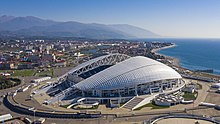
The
President
The World Robot Olympiad took place in the Adler Arena Skating Center on November 21–23, 2014.
The
The Fisht Olympic Stadium was also used to host 2018 FIFA World Cup football matches.
Since 2014, the city has hosted HC Sochi, who play at the Bolshoy Ice Dome in the Kontinental Hockey League.
Transportation

Public transport is represented mainly by bus and taxi. Sochi is served by the
The
Five of the railway stations of Sochi were renovated for the 2014 Winter Olympics. These are Dagomys, Sochi, Matsesta and Khosta railway stations. In Adler city district of Sochi, the original railway station was preserved and new railway station was built near it. Another new railway station was built in Estosadok, close to Krasnaya Polyana.
At some point, plans to construct the light metro network to serve the Olympics were considered; however, the Sochi Light Metro plan was abandoned in favor of the reconstruction of the railway.
Notable people

- Yuri Nikolaevich Denisyuk, physicist
- Mikhail Galustyan, comedian
- Andre Geim, physicist, graphene researcher and 2010 Nobel Prize winner[83]
- World No. 1tennis player
- Daria Kondakova, rhythmic gymnast
- Grigory Leps, singer, songwriter, musician of Georgian origin
- Slava Metreveli, Georgian/Soviet association football player
- Vladimir Nemshilov, Olympic swimmer
- Boris Nemtsov, politician
- Mordechai Spiegler, Russian-Israeli association football player and manager
- Vladimir Tkachenko, basketball player
- tennis player
- Kharis Yunichev, the first Soviet male swimmer to win an Olympic medal[84]
- Anna Zak, Israeli celebrity
Twin towns – sister cities
This article needs to be updated. (March 2022) |
Former twin towns
- Russian invasion of Ukraine.
- Russian invasion of Ukraine.
 Espoo, Finland (1989–2022)
Espoo, Finland (1989–2022) Pärnu, Estonia (1994–2022)[86]
Pärnu, Estonia (1994–2022)[86]
See also
References
Notes
- ^ a b c d e Registry of the Administrative-Territorial Units of Krasnodar Krai
- ^ a b c d "Sochi". Great Soviet Encyclopedia. (in Russian)
- ^ a b c d e f g Exposition of the Historical Museum of Sochi, partly reflected in Russian in"История Сочи". Archived from the original on October 11, 2010. Retrieved December 14, 2021. (History of Sochi) at the official site of the city
- ^ a b Official website of Sochi Archived January 11, 2014, at the Wayback Machine
- ^ a b c Городское Собрание Сочи. Решение №89 от 14 июля 2009 г. «Об утверждении генерального плана городского округа города Сочи». Вступил в силу со дня опубликования. (City Assembly of Sochi. Decision #89 of July 14, 2009 On the Adoption of the General Plan of the Urban Okrug of the City of Sochi. Effective as of the publication date.).
- ^ a b c d e f Russian Federal State Statistics Service (2011). Всероссийская перепись населения 2010 года. Том 1 [2010 All-Russian Population Census, vol. 1]. Всероссийская перепись населения 2010 года [2010 All-Russia Population Census] (in Russian). Federal State Statistics Service.
- ^ "26. Численность постоянного населения Российской Федерации по муниципальным образованиям на 1 января 2018 года". Federal State Statistics Service. Retrieved January 23, 2019.
- ^ a b c Law #679-KZ
- ^ "Об исчислении времени". Официальный интернет-портал правовой информации (in Russian). June 3, 2011. Retrieved January 19, 2019.
- ^ Почта России. Информационно-вычислительный центр ОАСУ РПО. (Russian Post). Поиск объектов почтовой связи (Postal Objects Search) (in Russian)
- ^ "RUSSIA: Južnyj Federal'nyj Okrug: Southern Federal District". City Population.de. August 8, 2020. Retrieved August 28, 2020.
- ^ "Оценка численности постоянного населения по субъектам Российской Федерации". Federal State Statistics Service. Retrieved September 1, 2022.
- ^ Rafael Saakov (February 4, 2014). "Sochi: The Russian city where I grew up". BBC. Retrieved August 28, 2020.
- ^ Sochi hosts 2014 Winter Olympics BBC Sport, July 4, 2007
- ^ PM Putin confirms Russian GP for 2014 GPUpdate, October 15, 2010
- ^ "F1 terminates Russian GP contract after cancellation of 2022 race".
- ^ a b Exposition of the Historical Museum of Sochi, partly reflected in Russian in История Сочи (History of Sochi) at the official site of the city
- ^ Mi, Ali. Çerkez tarihi
- ^ a b А. В. Твёрдый. Топонимический словарь Кавказа
- ^ "სოჭი", A Comprehensive Georgian-English Dictionary, 2006, 2 cilt ISBN 0-9535878-3-5
- ^ Византийский храм в Лоо (in Russian). Архитектура Сочи. May 16, 2012. Retrieved January 30, 2014.
- ^ "Генуэзцы". edemkavkaza.ru. Retrieved November 18, 2020.
- ^ "Крепость Годлик, Сочи – описание, история, фотография, а также интересные факты | Nicko.ru" (in Russian). May 19, 2017. Retrieved November 18, 2020.
- ^ Фунтиков, Илья (April 26, 2017). "Генуэзская крепость в Хосте". Новости Сочи Sochinews.io (in Russian). Retrieved November 18, 2020.
- ^ a b Sochi – from ancient sites to 2014 Olympics, information from the Historical Museum of Sochi
- ISBN 0-19-280232-1
- ^ Ahmed 2013, p. 161.
- ^ L.V.Burykina. Pereselenskoye dvizhenie na severo-zapagni Kavakaz. Reference in King.
- ^ Richmond 2008, p. 79.
- ISBN 978-0-8135-6069-4.
- ^ Shenfield, Stephen D. The Circassians: A Forgotten Genocide?, 1999
- ^ ISBN 588195775X
- ^ ISBN 978-5-89476-319-4
- ^ Stalin's ghost haunts Black Sea hotel at Mail & Guardian Online, Retrieved February 7, 2014
- ^ Голубева, Елена (September 25, 2013). Олимпийская столица – и для спортсменов, и для бизнесменов. Komsomolskaya Pravda (in Russian). Retrieved January 30, 2014.
- ^ Koenker, Diane P. (February 2014). "Sochi in the Russian Imagination". Foreign Affairs. – via Foreign Affairs (subscription required)
- ^ "Путин подписал закон о федеральной территории "Сириус"". news.ru (in Russian). December 22, 2020.
- ^ a b Travel Destinations Sochi Russia by Michael Totten | Traveler's Guide 360 Archived November 12, 2014, at the Wayback Machine. Travelersguide360.com (February 11, 2013). Retrieved on January 3, 2014.
- ^ a b "World Map of Köppen−Geiger Climate Classification". Archived from the original on September 6, 2010.
- ^ S2CID 128960702.
- ITAR-TASS. July 4, 2007. Archived from the original(in Russian) on July 5, 2007. Retrieved January 7, 2014.
- ^ Western Caucasus at Unesco Heritage Site. Retrieved July 7, 2007
- ^ Rybak, Elena A.; Rybak, Oleg O. & Zasedatelev, Yuri V. (1994). "Complex geographical analysis of the Greater Sochi region on the Black Sea coast". GeoJournal. 34 (4): 507–513.
- ^ "Weather and Climate – The Climate of Sochi" (in Russian). Weather and Climate (Погода и климат). Retrieved November 8, 2021.
- ^ "Weather and Climate – The Climate of Sochi" (in Russian). Weather and Climate (Погода и климат). Retrieved November 8, 2021.
- ^ "Soci (Sochi) Climate Normals 1961–1990". National Oceanic and Atmospheric Administration. Retrieved October 29, 2021.
- ^ "Погода в Сочи сейчас. Температура воды в море. Подробный прогноз. Сочи на карте погоды".
- ^ 80,000 of 138,572 (58%)
- According to 2014 official estimates, the population of Adlersky City District is 138,572, see "Оценка численности населения на 1 января 2014 года по муниципальным образованиям Краснодарского края [Estimated population on January 1, 2014 by the municipalities of Krasnodar Region]" (in Russian). Russian Federal State Statistics Service. April 15, 2014. Archived from the originalon June 14, 2014.
- The Moscow Times estimated in 2006 that there were about 80,000 Armenians in Adler, see Schreck, Carl (May 5, 2006). "Sochi's Armenian Diaspora Weeps". The Moscow Times. Archived from the original on May 30, 2014.
...Sochi's Adler district, home to about 80,000 ethnic Armenians...
- According to 2014 official estimates, the population of Adlersky City District is 138,572, see "Оценка численности населения на 1 января 2014 года по муниципальным образованиям Краснодарского края [Estimated population on January 1, 2014 by the municipalities of Krasnodar Region]" (in Russian).
- ^ Schreck, Carl. "Sochi's Armenian Diaspora Weeps". The Moscow Times.
Hamshen Armenians comprise most of Sochi's Armenian population...
- ISBN 978-5-89700-020-3.
- ^ 1897 Census Archived December 31, 2013, at the Wayback Machine. demoscope.ru (in Russian)
- ^ Всесоюзная перепись населения 1989 г. Численность наличного населения союзных и автономных республик, автономных областей и округов, краёв, областей, районов, городских поселений и сёл-райцентров [All Union Population Census of 1989: Present Population of Union and Autonomous Republics, Autonomous Oblasts and Okrugs, Krais, Oblasts, Districts, Urban Settlements, and Villages Serving as District Administrative Centers]. Всесоюзная перепись населения 1989 года [All-Union Population Census of 1989] (in Russian). Институт демографии Национального исследовательского университета: Высшая школа экономики [Institute of Demography at the National Research University: Higher School of Economics]. 1989 – via Demoscope Weekly.
- ^ Federal State Statistics Service (May 21, 2004). Численность населения России, субъектов Российской Федерации в составе федеральных округов, районов, городских поселений, сельских населённых пунктов – районных центров и сельских населённых пунктов с населением 3 тысячи и более человек [Population of Russia, Its Federal Districts, Federal Subjects, Districts, Urban Localities, Rural Localities—Administrative Centers, and Rural Localities with Population of Over 3,000] (XLS). Всероссийская перепись населения 2002 года [All-Russia Population Census of 2002] (in Russian).
- ^ Федеральная Служба Государственной Статистики. Краснодарский краевой комитет государственной статистики «Национальный состав и владение языками, гражданство. Итоги Всероссийской переписи населения 2002 года по Краснодарскому краю. Том 4», г. Краснодар, 2005
- Rosstat, Moscow, 2007
- ^ "Rekhaniya". Jewish Virtual Library.
- ^ a b Sochi: a city with no mosque, OpenDemocracy, October 22, 2010
- ^ В ауле Тхагапш произошло знаменательное для верующих мусульман событие. (in Russian). Shapsugiya.ru (September 9, 2010). Retrieved on July 26, 2012.
- ^ "Итоги социально-экономического развития муниципального образования город-курорт Сочи за 2014 год". Sochi.ru. Retrieved September 8, 2020.
- ^ "Основные итоги социально-экономического развития муниципального образования город-курорт Сочи за 2015 год". Sochi.ru. Retrieved September 8, 2020.
- ^ a b c d e f g h i j k "Информация о социально-экономическом развитии города Сочи за 2016 год". Sochi.ru. Retrieved September 8, 2020.
- ^ a b "Аналитическая записка об итогах социально-экономического развития города Сочи за 2017 год". Sochi.ru. Retrieved September 8, 2020.
- ^ Наталья Зубаревич (2013). "Крупные города России: лидеры и аутсайдеры" (PDF). Демоскоп Weekly. Archived (PDF) from the original on October 9, 2022. Retrieved September 8, 2020.
- ^ a b Alexey (September 3, 2015). "Инфографика: экономика города-курорта Сочи в цифрах". SOCHIru.com. Retrieved September 8, 2020.
- ^ "Рейтинг городов России по качеству жизни (Top – 20) – 2010 год – Страница 2 – Urbanica" (in Russian). Retrieved May 19, 2021.
- ^ "Integral ranking "TOP 100 Russian cities" based on 2013 data – Page 2 – Urbanica". urbanica.spb.ru. Retrieved May 19, 2021.
- ^ "Integral ranking "TOP Russian cities" based on 2014 data – Page 2 – Urbanica". urbanica.spb.ru. Retrieved May 19, 2021.
- ^ Urbanica (October 15, 2009). "Рейтинг городов России по качеству жизни (Top – 20) – 2010 год". Retrieved September 8, 2020.
- ^ "30 лучших городов для бизнеса — 2012". Forbes. Retrieved September 8, 2020.
- ^ Чумаков Дмитрий Владимирович. "Туризм в Сочи как драйвер регионального развития". European Research. Retrieved September 8, 2020.
- ^ Ольга Ефимова; Денис Зыков; Юрий Малов (May 17, 2018). "Обзор рынка торговой недвижимости г. Сочи". Retail.ru. Retrieved September 8, 2020.
- ^ International Olympic Committee (July 4, 2007). "Sochi Elected as Host City of XXII Olympic Winter Games". Retrieved July 4, 2007.
- ^ A Major Tuneup for a Sports Machine NYTimes.com, July 29, 2008
- ^ Bennetts, Marc (January 19, 2014). "Winter Olympics 2014: Sochi Games "nothing but a monstrous scam," says Kremlin critic Boris Nemtsov". Telegraph. London. Archived from the original on January 11, 2022. Retrieved February 4, 2014.
- ^ "The Sochi Olympics: Castles in the sand". The Economist. July 13, 2013. Retrieved August 8, 2013.
- ^ "The Economic Impact Of The Winter Olympics: Not Great For Russia But Sochi Stands To Gain". ibtimes.com. International Business Times. February 8, 2014. Retrieved February 10, 2014.
- ^ BBC News – Q&A: Gay rights in Russia. Bbc.co.uk (August 13, 2013). Retrieved on January 3, 2014.
- ^ Winter, Jana (January 21, 2014). "US, Russian forces hunt jihadist widow feared inside Olympic zone". FoxNews.com. Retrieved January 21, 2014.
- ^ "Power Supply to Be Stepped Up to Sochi by 2014". Archived from the original on October 12, 2012. Retrieved December 14, 2021.. Kommersant. July 6, 2007
- ^ Silk Way Rally. silkwayrally.com.
- Haymarket Publications. Retrieved October 14, 2010.
- ^ Kirby, Paul (April 17, 2022). "Why has Russia invaded Ukraine and what does Putin want?". BBC News. Retrieved April 22, 2022.
- ^ Andre Geim – Biographical, Nobel Prize winners (Physics, 2010)
- ^ Сильнейшие спортсмены СССР наши коллеги по движению «Мастерс»: Т-Я. swimmingmasters.ru
- ^ "Внешние связи". sochi.ru (in Russian). Sochi. Retrieved February 4, 2020.
- ^ "Welcome to Pärnu!". Retrieved October 21, 2023.
Sources
- Управление по взаимодействию с органами местного самоуправления Администрации Краснодарского края. Справочная информация №34.01-707/13-03 от 23 мая 2013 г. «Реестр административно-территориальных единиц Краснодарского края». (Department of Cooperation with the Organs of the Local Self-Government of the Administration of Krasnodar Krai. Reference Information #34.01-707/13-03 of May 23, 2013 Registry of the Administrative-Territorial Units of Krasnodar Krai. ).
- Законодательное Собрание Краснодарского края. Закон №679-КЗ от 1 апреля 2004 г. «Об установлении границ муниципального образования город-курорт Сочи и наделении его статусом городского округа», в ред. Закона №1756-КЗ от 3 июня 2009 г «О внесении изменений в некоторые законодательные акты Краснодарского края об установлении границ муниципальных образований». Вступил в силу со дня официального опубликования. Опубликован: "Кубанские новости", №64–65, 17 апреля 2004 г. (Legislative Assembly of Krasnodar Krai. Law #679-KZ of April 1, 2004 On Establishing the Borders of the Municipal Formation of the Resort City of Sochi and on Granting It Urban Okrug Status, as amended by the Law #1756-KZ of June 3, 2009 On Amending Various Legislative Acts of Krasnodar Krai on Establishing the Borders of the Municipal Formations. Effective as of the day of the official publication.).
- Historical Dictionary of Sochi, ISBN 9781876586232[Currently the only major work on the city in English.]
- Works by or about James Stanislaus Bell at Internet Archive (Journal of a Residence in Circassia During the Years 1837, 1838, and 1839)
External links
 Media related to Sochi at Wikimedia Commons
Media related to Sochi at Wikimedia Commons Sochi travel guide from Wikivoyage
Sochi travel guide from Wikivoyage- Official website of Sochi
- Official website of Sochi (in Russian)
- Secrieru, Stanislav: "The 2014 Winter Olympic Games in Sochi: Implications for the Caucasus" in the Caucasus Analytical Digest No.19
- Weather Report for Sochi, Russia
- Sochi at funiq.eu

